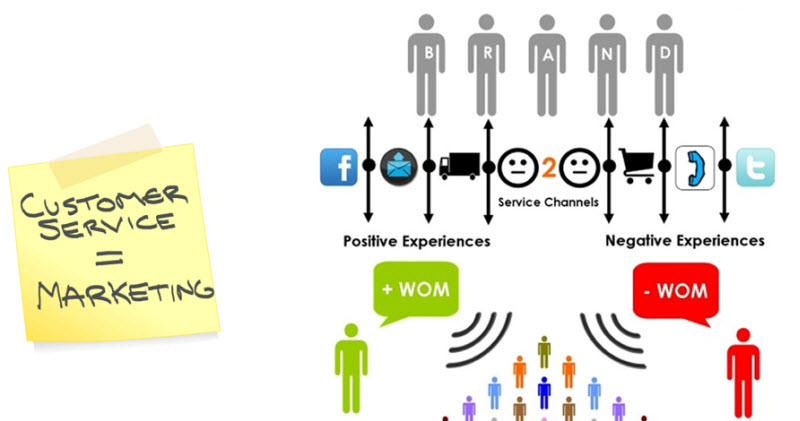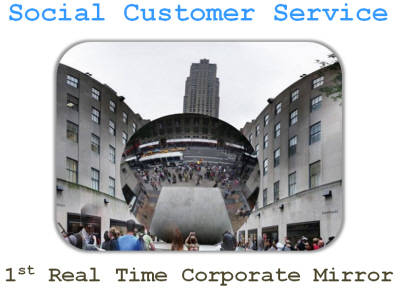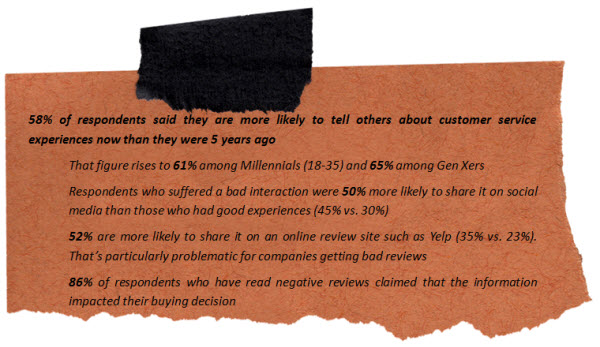
This post reflects on a missed opportunity between Marketing and Service. In particular Social Customer Service.
We are all aware of the overwhelming evidence that shows how impotent Marketing messaging has become to customers. A combination of low trust and increased self sufficiency means most content is tuned out.
Unfortunately this flies in the face of another home truth that Marketers now struggle with: the never ending demand for engaging content. Interestingly, a whole new software segment has been borne out of this very need to generate content able to trigger interaction.
So far this has proved culturally and logistically tough. So much so, that in spite of many rallying calls from digital marketing thought leaders, most pragmatic marketers have settled for ‘likes’ as evidence of success.
However they do know the net is closing and this currency is now so hyper inflated as to hold near zero commercial value. So what to do next?
Marketing and Service Can Help Each Other Out
If Marketers were to look over the fence and swap stories with their Service colleagues, they might notice some unmined opportunity that could help their cause. Although marketing communication is trending towards much reduced impact, social customer service is moving in the opposite direction.
In fact interactions via social customer service are weighted towards much more significant outcomes than brands are used to. But some are now catching on. For instance, Olaf Swantee is CEO of EE, the UK mobile brand. He now pops into his social media hub every Friday before leaving for the week to pick up the news.
This is hugely significant. A direct feed is established between customer and c-suite. Tell me how often that happened during the era of ‘private’ customer service interactions? I also find as an interesting side note, that despite its much lower volumes relative to voice interactions, social analytics has captured corporate interest much faster than traditional speech analytics.
 Olaf and others in the C-suite are recognising that this kind of social interaction provides a real time corporate mirror for all to see. Or as I have been saying a number of times over this summer, ‘Service Has Become A Spectator Sport’.
Olaf and others in the C-suite are recognising that this kind of social interaction provides a real time corporate mirror for all to see. Or as I have been saying a number of times over this summer, ‘Service Has Become A Spectator Sport’.
Social Customer Service: a game of high stakes poker
Obviously ‘weightier outcomes’ can work both for and against an organisation. In terms of betting which way the sentiment will fall, research suggests it’s an uphill task. I’ve seen a number of UK and US studies showing this.
For instance a 2013 one comes from Dimensional Research and Zendesk. Earlier this year they polled American consumers who had recently interacted with customer services in mid-sized companies. Their findings ring true on the level of human behaviour.
On top of all of that, it seems bad experiences are also remembered for longer.
Now if you are in Customer Service, this is not news. It comes with the territory. However as I said earlier, the reverse happens. Great outcomes can occur, sometimes from spectacular interventions. These are the nuggets that both Service and Marketing teams should have a joint plan for leveraging.
Both share a common interest here.
Marketing needs credible content. What better than customers praising your organisation? While Service needs to find every opportunity to swing that sentiment barometer towards positive. They also need some positive PR out in the market. So to spell it out, here is the idea.
Whenever a social customer service interaction ends on a strong, positive note with some form of customer endorsement, there is a plan to ‘Harvest The Wow’. Marketing and Service work through a checklist.
- Is it a one off? Or is there a bigger story – has the brand now fixed a recurring issue?
- Is there a customer or colleague ‘back story’ worth retelling?
- What are the messages around being a customer orientated organisation we want emphasised?
- Is there future value in reusing this content together with other validations?
Just be careful not to trip off into unjustified fantasy!
When It’s Right To Harvest That Wow
Here are two service stories that are definitely in the ‘wow’ category which took place over social channels and provide examples of what I’ve talking about.
My first one comes from industry colleague Ian Golding. It’s a story about sliced bread in the north of England. To be precise, Ian was slighted that his bread was not getting sliced! Within eighteen hours of the incident that caused Ian to tweet his complaint, a manager had reorganized his store layout and let Ian know what he had done as a result of his feedback.
This is a story of a brand with a clear intent to listen and act. As a result, they are also garnering the benefits. Ian’s meticulous post (he is a black belt ninja type after all) attracted 19 comments on his own blog and many retweets of which I was one. And that’s even before the Marketing team turns up.
The full story is here and is well worth reading.
My second example is US based. It’s all about real time responsiveness. It’s another great story with expert explanation. You may have read it.
The storyteller notices her connecting airport has delayed planes from landing because of a fire. Yet the departing plane for her final destination was still scheduled to leave on time. Through a series of tweets pre flight and during flight, the airline organised for her family to still get to her connecting flight.
They win her praise and attention of everyone who passes on that story to their own social networks. In my case it just became a best practice example in my one day course on social customer service. With a little help from the airline’s Marketing team that story could stay afloat even longer.
Both missed opportunities from a Marketing perspective to recognise and amplify highly credible content.
In Summary
So to bring matters to a close, Service and Marketing have yet another item to mark up on their One Agenda. Of itself ‘Harvesting The Wow’ will not entirely solve the Marketer’s quest for engaging content. But it does start a valuable trading partnership that has the potential to change brand perceptions if executing with imaginative flair.
Why not try it before others benefit?






Hi Martin,
Any story about a firm has helped solve a problem can provide content and evidence of what a company is doing. However, the bigger question is whether marketing is willing to wean itself off ‘campaigns’ and make that decision to go mining for ‘gold’ amongst their customer service interactions.
Adrian
Hi Adrian,
As ever those that are smart enough to adapt will start earliest. As of today most marketers are still still in campaign mindset underpinned with objectives that drive them in that direction.
Martin
Martin,
Isn’t it interesting that executives will look at social media analytics in preference to speech analytics? More interesting still is the fact that they prefer speech analytics to listening to calls.
Presumably they are too busy to listen to what their customers think?
James
Hi James,
Yes I would agree with your underlying criticism. However since there is no indication of a reformed interest, I’m happy to promote whatever source causes them to see the world outside-in.
We are still in a business world of introverted interests that become more extreme at the top of the pecking order. Hopefully one day this behaviour will be scoffed at by the next generation.
Martin,
Very interesting post, I think you are hinting at something that is not fully developed yet. There are a few items putting pressure on organizations today, but none is more powerful than the one that is blurring (nay, destroying) the lines between traditional life cycles in favor of continuum.
I a traditional life cycle each interaction is contained and controlled by a single entity (customer service and marketing in your above post) and it accomplished just one thing. Customers call for customer service, they get customer service. They later come in for marketing content, they get marketing content, etc. This is what sustained CRM for the past 15-20 years – the promise that we could use the data and content of one into the other (and similar to the comment you made in your post of looking over the wall and sharing tales of success).
The shift happened in the past 4-5 years to continuum: in a continuum each interaction is a self-contained life cycle: customers don’t just come for a customer service interaction, each interaction is a complete opportunity to do sales, marketing, hr, shipping, accounting, AND customer service. The systems that power continuum emphasize the access to people, data, processes and of course – self-service. Customers stop being “objects we service or market to or sell to” to become the ones initiating and ending the interaction on their terms. This, along with collaboration, became the calling card of the now defunct “social revolution”.
Organizations are waking up to this new reality, led by statistics that “buyers have between 60 and 80 percent of their decision made by the time they execute the sale”. We no longer have the ability to influence that decision with content as we used, but we have the opportunity to influence continuum with advocate recommendations (as you advocate – no pun intended, well maybe just a little) and to place content inside the communities that power those decisions to power them.
The game has changed dramatically, this is why the demand for content is so high and the quality and methods have changed. This is also why a traditional customer service interaction will fail even if delivering a positive outcome – the lack of a continuum to power that interaction and the results from it simply means you are just executing on a single-purpose interaction — which is definitely not what customers are looking for anymore.
Watch for this change to begin to take place in organizations around the world in the next few months-years.
Thanks for the opportunity to comment, keep up the good work (you are definitely one of the blogs I read often and totally appreciate your excellent curation on Twitter).
Esteban,
Thank you for commenting. Most eloquently put! The self sufficiency of customers is demanding a terrible price from organisations. That they rip down the walls segregating many long standing private parties. As you say they have no choice but to learn the new disciples of continuum. The nascent cross breeding from this will power future generations to act with new instinct.
BTW – your recent stuff on knowledge mgt is both excellent and aligned with what we are discussing here. And your encouragement is always most welcome-)